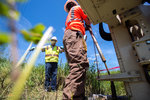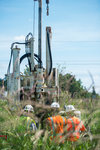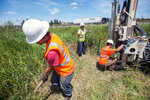



Before a hazardous waste site just south of Chehalis can be cleaned, crews with the U.S. Environmental Protection Agency must first dig deep into the ground to find where the contaminated groundwater is most prevalent.
EPA crews began drilling into the Hamilton/Labree Superfund site near North Hamilton Road west of Interstate 5 on Wednesday to collect groundwater samples.
Crews drilled 3-foot diameter holes about 50 feet into the ground. Small probes are attached to the drills and will collect data for 3D modeling software, Project Manager Tamara Langton said.
“This is more investigation to try to really focus in on where the worst contamination is so we can focus on where to put the thermal cleanup, specifically,” Langton said.
Work is scheduled to be finished by Aug. 8, at which point the EPA will look at the data and see where to target its cleaning efforts.
Depending on federal funding, cleanup will likely begin next summer, Langton said.
The cleanup, estimated to cost about $11 million, will be centered on a 10-acre portion of the Superfund site called the Hamilton Road Impact Area.
The EPA will first use a thermal heat treatment on the contaminated soils and then a biological treatment to break down and remove the contaminant tetrachloroethene, known as PCE, from the groundwater, Langton said.
PCE is a chemical used for dry cleaning, metal degreasing and other industrial processes. It is a carcinogen that can cause kidney problems and neurological issues.
The Washington State Health Department first found contamination at the site in 1993. It came from a spill or direct release of 100 to 700 gallons of liquid PCE into Berwick Creek aquifer.
“What we are working on now is the hottest spot, the hottest contamination,” Langton said. “We are really focusing on where we are going to put the thermal treatment so we can go quicker and more efficiently.”
The thermal treatment will reach 190.4 degrees, the boiling point for PCE. Thermal treatments typically take one to two months to heat up followed by four to six months of treatment time.
The biological treatment injects a liquid, similar to vegetable oil, into the ground to help the growth of bacteria and insects that eat away at the PCE, according to the EPA.
Another portion of the cleanup plan would be to reroute Berwick Creek around the contamination areas to help protect fish and animals. However, Langton said it may not be necessary if the thermal and biological cleanup goes as planned.
“The first thing I’m going to have to do is figure out what we are going to do with the creek. I’m going to have the Corps of Engineers look into it more fully to somehow keep the creek in place, and armor it and protect it,” Langton said. “When we do thermal and biological treatments, we may be able to leave the creek in place. That will make everyone happy, including the salmon.”
Last summer, the EPA approved the clean up plan for the Hamilton Road Impact Area, which is the most contaminated portion of the Superfund site.
“All the focus is currently on the Hamilton Road Impact Area,” Langton said.
There is not timeline for the remainder of the Superfund site cleanup. The EPA is working with the responsible party, the S.C. Breen Construction Co., which signed an order as a "potentially liable party." The company has paid for testing and studies of how to clean up the area.
In 1999, the EPA found 64 drums of PCE buried under a building owned by the S.C. Breen Construction Co. The barrels were removed and disposed of as hazardous waste.
There were never any charges for the contamination, and no one is currently drinking contaminated water since residents were hooked to the city of Chehalis water system.
The exact date of the PCE spill or release is unknown but it likely occurred before 1990, according to an EPA report.
Langton said the findings from the drilling work will be helpful in determining how to clean the rest of the site.
“What we are doing here at the Hamilton Road Impact Area will certainly impact what is going on downstream of here and that will be very telling,” Langton said.